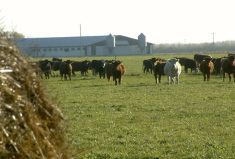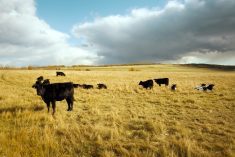May has been a productive month with calving having slowed down and the weather improving just enough for seeding to occur and pastures to green up. The cold and wet spring weather in most parts of the country has meant extra time to tend to calves to ensure they get a good start. It will be an interesting summer and fall to say the least, with the outlook calling for tight supplies to remain in Canada and the U.S. and in turn a continuation of the favourable market conditions that have resulted in the current environment of high prices. While there is some concern that consumers may start to feel sticker shock at the retail beef counter and turn to other, cheaper proteins I am confident that the experience of tossing a high-quality Canadian beef burger or steak on the barbecue is simply too much of a summer tradition to do without.
Read Also

Body condition, nutrition and vaccination for brood cows
One of the remarkable events of the past century related to ranching has been the genetic evolution of brood cows….
The Canadian Cattlemen’s Association (CCA) also had a busy month with activity in a number of important files. On May 19, the en banc oral hearing on U.S. mandatory country-of-origin labelling (COOL) was held in Washington, D.C. The CCA was well represented at the hearing and along with its coalition partners is now awaiting a decision from the court. There is no set timeline for when the court will announce its decision on the case law at the centre of the dispute around free-speech rights guaranteed by the First Amendment. The CCA is involved in this litigation as part of a coalition of meat and livestock organizations in the U.S., Canada, and Mexico that filed a lawsuit on July 8, 2013 seeking to strike down the USDA May 23 revision to the COOL regulation.
- More CCA reports: COOL case gets a reboot
The WTO compliance panel is expected to make its preliminary confidential report to the parties in late June, followed by its final report, again in confidence to the parties, about a month later. The panel’s report will be made public only after it is translated, likely in September or early October. Of course, that decision is likely to be followed by an appeal. If this process continues fully to its conclusion, Canada could be authorized to impose retaliatory tariffs on U.S. exports sometime in 2015.
I travelled to Mexico for the Confederacion Nacional de Organizaciones Ganaderas (CNOG) annual convention. I met with CCA’s Mexican and U.S. cattle counterparts and was pleased to introduce them to Agriculture and Agri-Food Minister Gerry Ritz. The minister was in Mexico for a trilateral meeting of North American agriculture leaders to discuss NAFTA and also to address cattle industry leaders from Mexico, the U.S. and Canada at the convention. Minister Ritz urged Mexican Agriculture Secretary Enrique Martínez to publish a list of items his government will target for retaliation regarding COOL and encouraged CNOG member producers to put some pressure on their government to publish such a list.
I told my counterparts how much work the minister does to open markets for Canadian beef and the minister commented on the strong relationship he has with the CCA. CNOG and National Cattlemen’s Beef Association leadership were clearly impressed by the relationship CCA has with the minister.
The CCA travelled to the latest Trans-Pacific Partnership (TPP) ministerial meetings in Singapore held May 19-20. Along with CCA’s partners in the Five Nations Beef Alliance (FNBA) from Australia, New Zealand and the U.S., the CCA urged all participants involved in the TPP negotiations to recommit to securing a comprehensive, non-discriminatory outcome — one which eliminates tariffs on all products and addresses behind-the-border trade barriers. The CCA stands with its FNBA partners in insisting upon full tariff elimination for beef by all TPP countries.
These trips all work towards achieving expanded market access for Canada’s beef cattle producers. Under the terms of the Canada-Korea FTA, the 40 per cent Korean tariff on fresh and frozen beef will be fully eliminated in 15 equal annual steps and the 18 per cent tariff on offals will be fully eliminated in 11 equal annual steps.
Korea will also provide Canada a toehold in Asia and will add renewed emphasis on negotiations with Japan. In Japan, the CCA’s objective is that Canada negotiate the elimination of both the 38.5 per cent tariff and the safeguard trigger (tariff increases to 50 per cent if imports increase beyond a set formula) in either the TPP or in a bilateral agreement between Canada and Japan.
Prime Minister Stephen Harper announced the National Conservation Plan (NCP) in May. The CCA looks forward to working with the Government of Canada on the details of the plan and to ensure that working landscapes are part of the NCP. The NCP supports voluntary conservation and restoration practices, making it a good fit with beef cattle production.
The CCA continues to refine the five-year strategic plan for industry. This comprehensive draft strategy aims to achieve targeted industry goals that are aligned with the industry’s vision and mission under four key pillars. This remains a highly collaborative process and is being expertly managed by the capable staff at the CCA on behalf of industry. It is exciting to see this strategy continue to take shape. c















